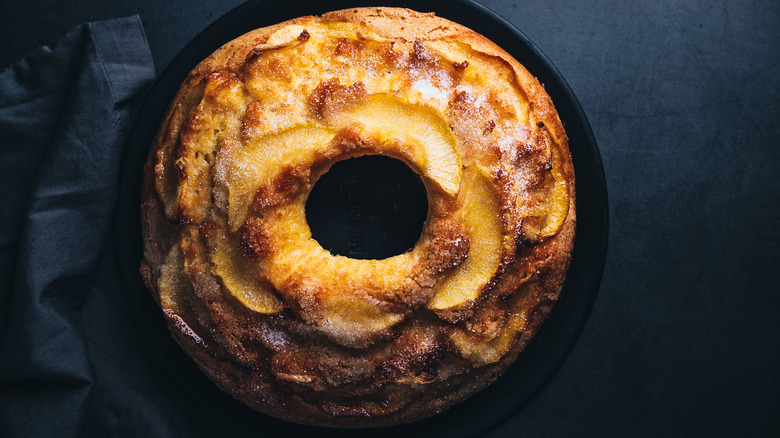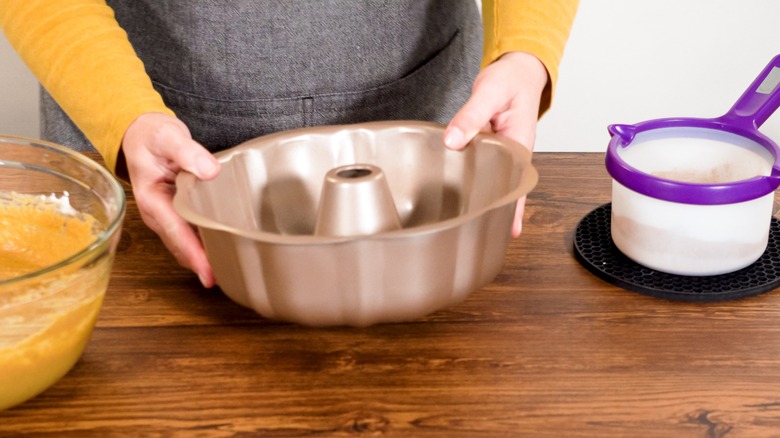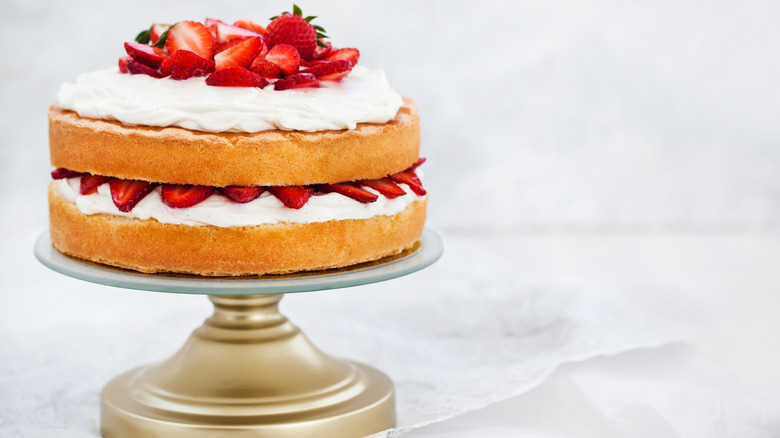Give Your Cakes A Delicious Crust With One Simple Swap
Adding a crispy crust to any cake you bake will complement its soft, moist crumb perfectly, creating next-level texture. You can achieve this ever-so-delicate crunch by dusting a greased cake pan with sugar instead of flour. Swapping out flour for sugar produces a lacy caramelized layer — somewhat similar to a lace tuile — that's light enough to slice through easily with a spoon.
Better still, as with flour, the sugar helps the cake release from the pan. But unlike flour, it won't create a potentially starchy, unappetizing, discolored residue on the cake's surface. Dusting a pan with sugar instead of flour isn't a novel hack, it's actually the traditional method for preparing pans for Bundt cakes and ramekins for chocolate soufflés. Both bundt cakes and chocolate soufflés are often topped with a small dusting of powdered sugar, or a modest glaze or dollop of whipped cream, leaving the majority of the desserts' surfaces plain. A crackly, thin crust livens up their simplicity deliciously.
How to get the perfect sugar crust
For the perfect sugar crust, you'll want to grease the pan generously with either vegetable oil or vegetable shortening. Though butter can add great flavor, it burns more easily than oil thanks to its lower heat tolerance, and you want to ensure the sugar doesn't turn dark and bitter from smoking. Butter also contains milk solids, which separate from the water content when heated, and this water can cause the sugar crystals to dissolve during the baking process, leaving you with a crust that's far from crispy.
You also want to avoid using cooking sprays, as they do not coat the pan heavily enough, and, without flour, can lead to your cake sticking. To get the crust just right, use around ⅓ cup of granulated sugar with 1 to 2 tablespoons of vegetable oil or shortening. Be sure to grease the pan evenly with a pastry brush, and don't leave clumps of sugar inside the pan. It's important to toss out any remaining sugar to avoid the formation of chewy sugar blobs.
What types of cakes are ideal for a sugar crust?
Although you can create a sugar crust for any cake you bake, it's especially ideal for round cakes where every slice gets bit of crust on the side. Naked cakes — cakes that aren't frosted from top to bottom — are a perfect use case for the sugar crust; not only does it add deliciousness, but it also adds some visual flair to the cake with ornamental, richly colored lace patterns.
Adding a sugar crust is also an easy hack to prevent berry cakes from getting soggy — a common problem, and easy to do given that these cakes are often made from angel food or white cake, which are more fragile than sponge cakes or pound cakes. A sugar crust is also a fabulous addition to coffee cakes and Italian orange cakes; plus, you can use it on cupcakes to add a delightful surprise in the first bite while balancing the smooth, rich cap of airy frosting. Do the same to morning muffins: The slightly sweet, crispy exterior can turn a plain bran muffin into a more appetizing treat. You can also take the crunch level on a pan of brownies to the extreme by dusting it with sugar, or add some extra crunch and caramelization to a pan of standard Madeleines to make them especially satisfying when dipping in a cup of coffee or tea.


